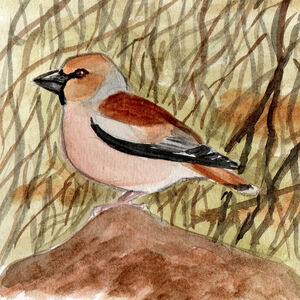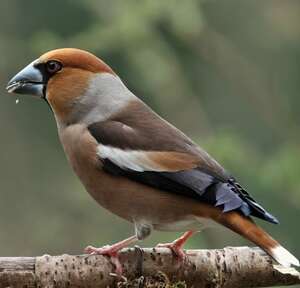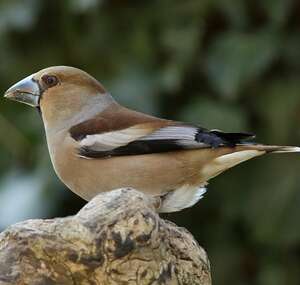Hawfinch
Coccothraustes coccothraustes - Grosbec casse-noyaux Gros-bec casse-noyaux
Identification
The Hawfinch is an unmistakable finch due to its large size, silhouette, colourful plumage and its large head with a very big beak. In size and corpulence, it is intermediate between a House Sparrow and a starling (16-18 cm, 70-80 g). The large head and short tail give it a compact silhouette which, in flight, combined with powerful wing beats, is very distinctive. The adult male of the nominate subspecies which inhabits the European continent is very colourful. The head is russet with the back of the cap chestnut-coloured. The conical, very strong beak is steel blue to dark grey, pale blue at the base. It is encircled with black, narrowly at the forehead, more widely elsewhere, the black encompassing the eye and forming a bib on the chin. The iris is pinkish to reddish-brown. The nape and sides of the neck are light grey in a half-collar, the mantle, upper back and small wing coverts a deep brown colour, the lower back, rump and the upper tail coverts the same colour as the head. In the extension of the body, the short tail is of this same brown-orange colour, broadly ended in white and with the outer rectrices blackish. The remiges are black with white areas at the base which can only be seen in flight and with blue reflections on the inner primaries and secondaries. The greater coverts are of three colours in their visible part, the outer ones ended in black, the intermediates white and the inner ones pale beige-orange. The medium coverts are dark grey and broadly ended in white. The lower parts, from the throat to the abdomen, are of a vinous beige, paler in the centre, with the exception of the lower abdomen and under tail coverts which are white.The underside of the wing is bi-coloured, white in front (coverts and base of the remiges) and grey at the back. The legs are pink. The adult female is identical to the male, but with a more muted plumage, less vivid colours and less striking black around the beak. There is not really an eclipse plumage, but the colours are duller in winter and the beak paler, pinkish horn. The juvenile is easily distinguished by its much paler plumage than that of the female. Its head is tinged with yellow, the mantle is pale brown, the lower parts light beige are completely spotted with brown, and the blue ornamentation of the remiges is very reduced. The beak is horn. The young male already distinguished itself from the female by the black which surrounds the base of its beak. The plumage will then gradually evolve towards the adult state throughout the interseason. The 6 subspecies described differ only in details of measurements and colours.
Subspecific information 6 subspecies
- Coccothraustes coccothraustes coccothraustes (Europe to c Siberia and n Mongolia)
- Coccothraustes coccothraustes buvryi (nw Africa)
- Coccothraustes coccothraustes nigricans (s Ukraine, the Caucasus, ne Turkey and n Iran)
- Coccothraustes coccothraustes humii (s Kazakhstan and e Uzbekistan to ne Afghanistan)
- Coccothraustes coccothraustes shulpini (se Siberia, ne China and Korea)
- Coccothraustes coccothraustes japonicus (Kamchatka Pen., Sakhalin and Kuril Is. and Japan)
Foreign names
- Grosbec casse-noyaux,
- Picogordo común,
- bico-grossudo-eurasiático,
- Kernbeißer,
- meggyvágó,
- Appelvink,
- Frosone,
- stenknäck,
- Kjernebiter,
- glezg obyčajný,
- dlask tlustozobý,
- Kernebider,
- nokkavarpunen,
- durbec comú,
- Kjarnbítur,
- grubodziób (zwyczajny),
- dižknābis,
- dlesk,
- Дубонос,
- シメ,
- 锡嘴雀,
- stenknäck,
- 臘嘴雀〔錫嘴雀〕,
Voice song and call
You would expect a powerful and sonorous song from this large finch, well not at all. The Hawfinch's song is a brief and rarely varied sequence of simple notes, with a high tone and a metallic timbre. It is not very musical and carries little. It goes unnoticed in the morning concert that animates the forest in spring. On the other hand, its loud cries do not go unnoticed. It has two usual cries. First of all the most frequent one, a striking, far-reaching, metallic tik. From a distance, it might remind one of a robin's. It is emitted in all circumstances, in flight as well as perched. The other cry is a sustained siih that the bird can vary to its liking. These two cries are often emitted alternately. They are contact cries between partners or between members of a group. The birds in migration emit finer and stretched siiihs, probably to maintain the cohesion of the group.
Habitat
The Hawfinch is primarily a forest bird. In the west of its range, it particularly enjoys deciduous forests, especially oak forests, while in the east it is also found in mixed forests as well as coniferous forests such as pine forests or juniper groves.
Behaviour character trait
The Hawfinch is a hard bird to observe. This is already due to the forest environment it frequents which is a closed environment by definition. Plus, it has the habit of perching high in the trees and flying above the canopy. It is also a rather timid bird that is hard to get close to. Finally, it is never abundant like the chaffinch for example. It is rather during the period outside of reproduction when one has the best opportunities to observe it, especially in winter near feeders if one is lucky. Indeed, it does not despise winter feeding stations and sunflower seeds that it finds there, following the law of least effort that is not exclusive to mankind.
We can also easily see it while traveling in the forest in autumn or spring. It perches on the side of roads to pick up hazel and hornbeam seeds, taking flight at the last second. Its robustness, its hunched silhouette, the white of its wings and tail draw attention. During the migration period, especially when reproduction has been good but then the resource becomes scarce, it migrates in large numbers towards the southwest and its passage in noisy troops can become unusual, detectable at migration monitoring points like there are many of them. The Hawfinch is monogamous and territorial during the breeding season, but the territoriality is not very strong and the nuptial couples can form loose colonies. As soon as the young are emancipated, family ties diminish, individuals become gregarious and move in troops. The importance of displacements varies from one population to another and from one season to another. The birds from temperate regions are erratic or partial migrants while those from regions with a marked continental climate are all migrants.The most visible morphological characteristic of the species is its impressive beak, which goes along with a very developed musculature, hence the large head of the bird. The mandibles develop such power that they can crack up to cherry stones to access the almonds. It is this adaptation that earned it its French name. Furthermore, the inside of the beak is provided with grooves to properly hold the seed or the stone. Ringers know very well this specific characteristic and avoid during the ringing sessions to get their fingers pinched by a hawfinch as it is very painful.Flight
The flight of the Hawfinch is a direct and swift one. Its wing beats are powerful, the sequences alternated with briefer ones with wings tucked in, like all finches. But the flight is so energetic that it is almost wavelike. The bird's silhouette, its size, the white of its wings and tail, and the characteristics of its flight are typical and allow for easy recognition, all the more so given the distinctive calls emitted at the time.
Dietfeeding habits
The Hawfinch is naturally drawn to vegetable items for its diet. Its diet contains a wide variety of seeds, but mostly woody ones with hard, thick outer coating.
With its huge beak, it is capable of cracking cherry stones by the mere pressure of its mandibles which develop a strength of more than 50 kg. It also eats buds in late winter, young tree sprouts in the spring and fruits at the late summer. Regarding fruits, it is more interested in the seeds they contain than in the pulp which is often discarded, like the Brambling also does. The youngs are fed, like all seed eaters, with animal preys, various invertebrates, insect larvae like caterpillars, etc. In the winter, it can be attracted to the bird feeder with sunflower seeds.Reproduction nesting
The breeding season of the Hawfinch runs from the end of March until the end of July, varying based on the latitude and climate conditions of the areas it inhabits. The species is monogamous and only raises one brood a year. The male courts the females, with his wingspend, his body alternatingly dipping right and left, punctuating the display with cries. It also provides food to the female, directly delivering it into her beak. At this period, he is particularly aggressive and nervous. The Hawfinch usually nests in isolated pairs, but also sometimes in loose colonies, depending on the hosting capacity of the environment.
A grove can house only one couple...or none. The male chooses the nesting site and begins to construct, almost always more than three meters high on a branch. In Western Europe, the seat of the nest is made of intertwined twigs and is quite flat. Its cup is then lined mainly of rootlets by the female. The nest thus looks like a large Orange-tip butterfly nest. Elsewhere on the continent, its composition can vary according to the forest environment. The female lays 3 to 5 eggs of light-colored, ivory, grey, blue, or pale green shade, with prominent dark spots. Incubation lasts 11 to 13 days, done by the female who is fed in the nest by the male. The hatchlings are fed insects, mostly caterpillars, by their parents. They leave the nest at the age of 12 to 13 days, but remain dependent on the adults for another 15 days, and only reach independency at the end of a month. Then, they form multi-familial groups. Reproductive success can be high, for example, close to 75% in a Dutch study based on close to 300 eggs. Adults and juveniles are a usual prey of the Long-eared Owl and the Northern goshawk.Geographic range
The Hawfinch occupies temperate forests of the Eurasian continent in a continuous band stretching from the Atlantic coast to the Amur region in Russia, with an extension to the south of Kamchatka via the Kuril Islands. To the north, its distribution area only extends to the south of Scandinavia. To the south, the most southerly regions occupied are the Maghreb, northern Turkey (Pontic Chain), northern Iran (Elburz Mountains), the Tien Shan and North Korea. The populations at the extremes of its range, European and East Asian, are sedentary, erratic or at most partially migratory. On the other hand, those of Russia are entirely migratory, as the winter conditions require. The wintering grounds largely correspond to the breeding grounds but extend a little further to the south. To the west, it includes the Mediterranean region and Asia Minor, while to the east it extends to south China, South Korea and Japan.
Threats - protection
IUCN conservation status
concern
in the Wild
threatened
evaluated
The Hawfinch is currently not threatened. It is quite common in the forests that suit it, but never abundant. The results of the French STOC-EPS program show that over the last 20 years, the species has seen a moderate increase, which is good news in a general gloomy context. It must be said that the forest environment resists better than the others to the loss of biodiversity.
Sources of information
- IOC World Bird List (v15.1), Gill, F and D Donsker (Eds). 2025-12-07.
- HBW Alive,
- xeno-canto, Sharing bird sounds from around the world,
Other sources of interest
 Specification sheet created on
13/07/2023 by Jean François
Specification sheet created on
13/07/2023 by Jean FrançoisTranslation by AI Oiseaux.net
© 1996-2025 Oiseaux.net
- Accipitriformes
- Aegotheliformes
- Anseriformes
- Apodiformes
- Apterygiformes
- Bucerotiformes
- Caprimulgiformes
- Cariamiformes
- Casuariiformes
- Charadriiformes
- Ciconiiformes
- Coliiformes
- Columbiformes
- Coraciiformes
- Cuculiformes
- Eurypygiformes
- Falconiformes
- Galliformes
- Gaviiformes
- Gruiformes
- Leptosomiformes
- Mesitornithiformes
- Musophagiformes
- Nyctibiiformes
- Opisthocomiformes
- Otidiformes
- Passeriformes
- Pelecaniformes
- Phaethontiformes
- Phoenicopteriformes
- Piciformes
- Podargiformes
- Podicipediformes
- Procellariiformes
- Psittaciformes
- Pterocliformes
- Rheiformes
- Sphenisciformes
- Steatornithiformes
- Strigiformes
- Struthioniformes
- Suliformes
- Tinamiformes
- Trogoniformes


































